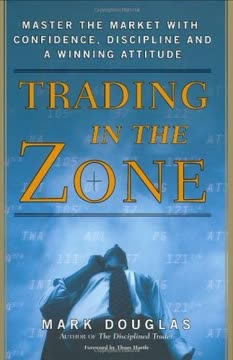Key Takeaways
1. Master the CAN SLIM system for selecting winning stocks
The stocks you select should show a major percentage increase in current quarterly earnings per share (the most recently reported quarter) when compared to the prior year's same quarter.
Current earnings growth is crucial. The CAN SLIM system emphasizes the importance of strong current quarterly earnings growth, ideally 25% or higher, compared to the same quarter last year. This indicates a company's momentum and potential for future growth.
Annual earnings matter too. Look for companies with consistent annual earnings growth of at least 25% over the past three years. This demonstrates sustained performance and management effectiveness.
Other key factors include:
- New products, management, or industry conditions (N)
- Supply and demand reflected in trading volume (S)
- Leader in its industry group (L)
- Institutional sponsorship (I)
- Market direction (M)
2. Use charts to time your buys and sells with precision
Proper chart reading will help you recognize the right time to buy and sell stocks.
Learn to read stock charts. Charts provide visual representations of a stock's price and volume history, helping you identify optimal entry and exit points. Key patterns to look for include cup-with-handle, double bottom, and flat base formations.
Identify proper buy points. The ideal time to buy is when a stock breaks out of a sound base pattern on heavy volume. This often occurs at or near new high prices, contrary to the common desire to "buy low."
Use charts for selling decisions. Charts can help you recognize when a stock is topping or showing signs of weakness, allowing you to sell before major declines occur.
3. Focus on companies with strong earnings and sales growth
The greater the percentage increase, the better.
Prioritize earnings growth. Look for companies with quarterly earnings growth of at least 25%, with higher percentages (40% to 500%) being even more desirable. This indicates a company's ability to grow profits rapidly.
Sales growth matters too. Seek companies with sales growth of at least 25% in the most recent quarter. Accelerating sales growth over the past few quarters is an even stronger indicator of potential success.
Additional financial metrics to consider:
- Return on equity (ROE) of 17% or higher
- Improving profit margins
- Strong cash flow relative to earnings per share
4. Identify new, innovative companies and products
It takes something new to produce a startling advance in the price of a stock.
Focus on innovation. Look for companies introducing revolutionary products or services that have the potential to create new markets or disrupt existing ones. These companies often experience rapid growth and stock price appreciation.
Consider company age. Many of the best-performing stocks are relatively young companies, often within 8-15 years of their initial public offering (IPO). These companies tend to be more agile and growth-oriented than older, established firms.
Watch for industry shifts. Pay attention to changes in industry conditions that could create opportunities for new leaders to emerge. This might include technological advancements, regulatory changes, or shifts in consumer behavior.
5. Understand market direction to sync your investing strategy
You positively must always act to preserve as much as possible of the profit you've built up during a bull market rather than ride your investments back down through difficult bear market periods.
Learn to read market trends. Study the major market indexes (S&P 500, Nasdaq Composite, Dow Jones Industrial Average) to understand overall market direction. This helps you align your investing strategy with broader trends.
Recognize market stages. Be aware of whether you're in a bull market, bear market, or transitional period. Your buying and selling strategies should adapt to these different market conditions.
Use IBD's "Big Picture" column. This daily analysis can help you interpret market conditions and make informed decisions about when to be aggressive or defensive in your investing approach.
6. Cut losses quickly and let winners run
The whole secret to winning big in the stock market is not to be right all the time, but to lose the least amount possible when you're wrong.
Implement a strict loss-cutting rule. Sell any stock that falls 7-8% below your purchase price, without exception. This prevents small losses from becoming large, devastating ones.
Let your winners run. Avoid the temptation to sell too quickly when a stock is performing well. Use trailing stops or other methods to protect profits while allowing for continued upside potential.
Develop a profit-taking strategy. Have a plan for when to take partial or full profits in your winning stocks. This might be based on specific price targets, time frames, or changes in the stock's fundamental or technical picture.
7. Develop discipline and emotional control in investing
Winners in the stock market need perspective, discipline, and self-control above all else.
Control your emotions. Successful investing requires overcoming natural human tendencies towards fear and greed. Develop the discipline to stick to your strategy and rules, even when it feels uncomfortable.
Avoid common psychological traps:
- Holding onto losing stocks hoping they'll "come back"
- Selling winners too soon out of fear
- Buying stocks simply because they've declined in price
- Ignoring your sell rules due to overconfidence
Practice patience. Great stock market gains often come from holding quality stocks for extended periods, sometimes years. Develop the patience to let your investment thesis play out.
8. Continuously educate yourself on investing principles
You can definitely learn to invest wisely. This book will provide you with the investment understanding, skills, and methods you need to become a more successful investor, if you're willing to work at it.
Commit to ongoing learning. The stock market is constantly evolving, and successful investors never stop educating themselves. Read books, attend seminars, and study the methods of successful investors.
Analyze your successes and failures. Regularly review your investment decisions, both good and bad. Learn from your mistakes and identify patterns in your successful trades to refine your strategy.
Stay informed, but filter information. While it's important to stay up-to-date on market news and company developments, be selective about the information you act upon. Focus on facts and data rather than opinions or predictions.
Last updated:
FAQ
What's The How to Make Money in Stocks Complete Investing System about?
- Investment Strategy Focus: The book outlines the CAN SLIM strategy, which combines both fundamental and technical analysis to identify winning stocks. It emphasizes understanding market trends and stock performance.
- Historical Insights: It provides insights from over a century of stock market history, showcasing successful companies and their characteristics. Historical data is used to illustrate recurring patterns.
- Practical Guidance: Offers actionable advice on stock selection, timing, and risk management, making it suitable for both novice and experienced investors.
Why should I read The How to Make Money in Stocks by William J. O'Neil?
- Proven Success: The CAN SLIM method has shown significant returns, with a 2,763% result compared to 3.3% for the S&P 500 from 1998 to 2009.
- Comprehensive Learning: Covers both psychological aspects of investing and technical skills needed to analyze stocks effectively, providing a deeper understanding of market dynamics.
- Empowerment: Encourages readers to take control of their investments, providing the knowledge needed to make informed decisions.
What are the key takeaways of The How to Make Money in Stocks?
- CAN SLIM Method: Introduces the CAN SLIM acronym, crucial for identifying potential winning stocks, focusing on earnings, new products, and market direction.
- Sell Rules: Emphasizes having strict sell rules, such as cutting losses at 7% or 8% to protect capital, which is essential for long-term success.
- Market Timing: Teaches how to analyze market trends and adjust investment strategies, recognizing when to buy and sell.
What is the CAN SLIM method in The How to Make Money in Stocks?
- Current Earnings: Focus on stocks with significant quarterly earnings growth, ideally 25% or more, indicating strong company performance.
- Annual Earnings: Look for companies with consistent annual earnings growth over the past three years, reflecting stability.
- New Products and Management: Invest in companies introducing innovative products or having new management that can drive growth.
How does The How to Make Money in Stocks suggest I read stock charts?
- Chart Patterns: Recognize specific patterns like the "cup with handle," indicating potential buying opportunities.
- Volume Analysis: Volume is a critical indicator; increasing volume on price advances suggests strong demand.
- Historical Context: Study historical charts of successful stocks to identify recurring patterns and behaviors.
How does The How to Make Money in Stocks suggest I manage my investments?
- Cut Losses Early: Sell stocks that fall 7% to 8% below the purchase price to prevent small losses from becoming larger ones.
- Diversification Strategy: Avoid over-diversifying; focus on a smaller number of high-quality stocks, typically 8 to 12.
- Long-Term Perspective: Adopt a long-term view, allowing investments to compound over time with patience and discipline.
What are the selling rules outlined in The How to Make Money in Stocks?
- Cut Losses Quickly: Sell stocks that drop 7% to 8% below the purchase price to minimize losses and protect capital.
- Take Profits: Consider taking profits when a stock rises 20% or more to lock in gains before potential downturns.
- Monitor Market Conditions: Be aware of overall market conditions and adjust selling strategies accordingly.
What are the common mistakes investors make according to The How to Make Money in Stocks?
- Holding Losing Stocks: Many investors hold onto losing stocks, hoping for recovery, leading to larger losses.
- Ignoring Market Trends: Failing to recognize market direction can lead to poor investment decisions.
- Overdiversification: Owning too many stocks can dilute focus and make it harder to manage investments effectively.
How can I determine market direction as suggested in The How to Make Money in Stocks?
- Daily Market Analysis: Monitor major market indexes like the S&P 500 and Nasdaq for price and volume changes.
- Distribution Days: A series of distribution days can indicate a market top, essential for timely selling.
- Follow-Through Days: Recognize follow-through days, which confirm a new market uptrend, as a positive sign.
What is the significance of institutional sponsorship in The How to Make Money in Stocks?
- Demand Indicator: Institutional sponsorship indicates strong demand, as large investors have significant buying power.
- Quality of Ownership: Emphasizes the importance of the quality and performance records of institutional owners.
- Increasing Ownership: Look for stocks with increasing institutional ownership, signaling growing confidence.
How does The How to Make Money in Stocks address market timing?
- Market Direction: Understanding market direction is crucial; buy stocks in an uptrending market for higher success.
- Follow-Through Days: These indicate a potential market rally, helping investors time their entries effectively.
- Avoiding Emotional Decisions: Advocates for a disciplined approach, relying on data and established rules.
What are the best quotes from The How to Make Money in Stocks and what do they mean?
- “The best offense is a strong defense.”: Highlights the importance of risk management in investing.
- “If a speculator is correct half of the time, he is hitting a good average.”: Emphasizes managing losses effectively.
- “Bulls make money and bears make money, but pigs get slaughtered.”: Warns against greed, suggesting taking profits.
Review Summary
The How to Make Money in Stocks Complete Investing System receives mixed reviews. Many readers find it informative and comprehensive, particularly for novice investors. The book is praised for its clear structure, historical perspective, and detailed chart analysis. However, some criticize it for being repetitive and overly promotional of the author's website. The CAN SLIM investment strategy is frequently mentioned. Readers appreciate the risk management insights but note the content can be dense and challenging. Some find it more applicable to US markets than international ones.
Similar Books










Download PDF
Download EPUB
.epub digital book format is ideal for reading ebooks on phones, tablets, and e-readers.






